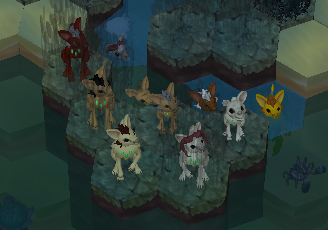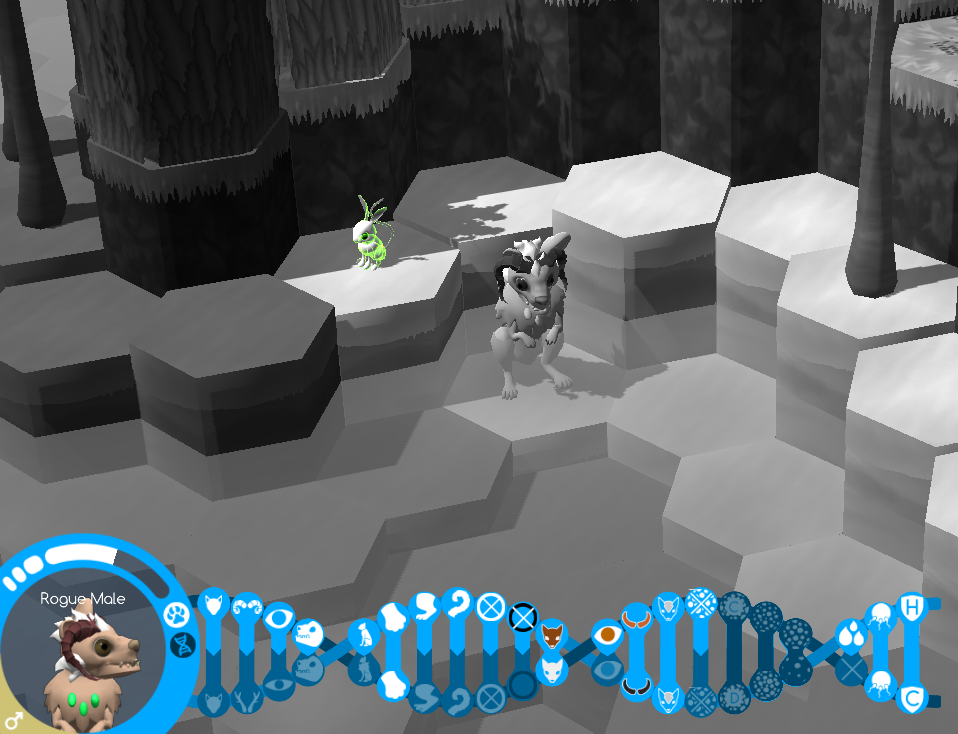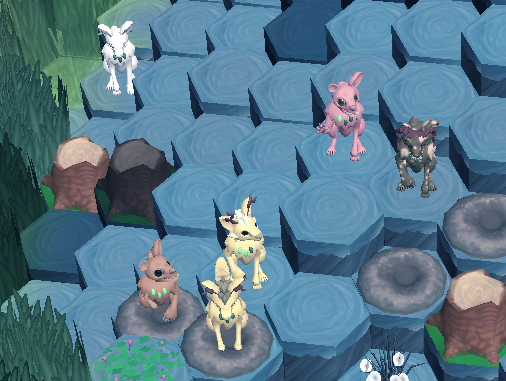-
Posts
104 -
Joined
-
Last visited
Content Type
Profiles
Forums
Events
Everything posted by PopsicleNinja
-
Meanwhile, it’s summer in America, and it’s definitely not fire season in my niche world. I rarely see more than three fires at a time, and almost all of the fires I’ve seen have spread two or three tiles before extinguishing themselves. The largest fire I’ve ever seen was as big as 15-20 tiles, and it wasn’t even close to my creatures. The only fire that sparked dangerously close to my creatures was extinguished by rain while it was still an ember.
-
My tribe in story mode had a problem where none of my home stars had a partner that matched up, which resulted in a similar situation to having one gender.
-

What’s your favourite island type?
PopsicleNinja replied to Stormwolf2018's topic in Discussion & Feedback
I really like being in the savanna, because it provides a challenge that is difficult without becoming tedious. I also love Whale Island because I can go anywhere I want, though I think it's a little OP because I encountered it in Story Mode once and went straight to Crossing. -
Because just as your creatures can adapt to every biome, why wouldn't other animals? Bunnies It never made sense to me how bunnies are white everywhere. Here are some different variants: Grassland Bunny, which looks like it's current appearance but brown. It replaces the current white bunny. Arctic Bunny, white and with a fluffy tail. They have 1 defense. Savanna Bunny, a regular bunny but beige, and has 1 stealth. Swamp Bunny, a black bunny that can safely eat poison berries. (Because I don't think swamps should be exempt from bunnies being a nusiance.) Balance Bears Just in case you thought there were no truly invincible predators on Deadly Hills. Brown Bear, a grassland version of the balance bear. Bearyenas Because Deadly Hills isn't the only killer island out there, what if the non-killer bearyenas were slightly more dangerous? Mountain Bearyena, which is white. It has cold resistance, and has 1 defense and 3 strength. It spawns in the Frost Lands. Jungle Bearyena, which is slightly smaller. It has stealth and scentless, so it's harder to hear/smell. It spawns in the Deep Jungle. Ramfoxes The concept of a predator that spawns in a pack is interesting to me, I'm not sure if it should be limited to one biome. Red Ramfox, spawns in the grasslands on islands that aren't easy, not counting Home Island or Crossing. Savanna Ramfox, spawns on islands with hot climates. They are beige with large ears.
-

More customization options for sandbox mode
PopsicleNinja replied to Philo's post in Feature Requests
Really? In my experience, healing plants are way rarer than that. I typically never explore the entire island, I just go in a path from one port to the next, and I usually see 1-3 healing plants on any given island (depending on biome, of course). -

More customization options for sandbox mode
PopsicleNinja replied to Philo's post in Feature Requests
I was thinking about what I would do if I had this option, as a challenge run: If I'm in story mode, I'd turn the tutorial off. I don't need it. If I'm in sandbox, I'd start with 10 creatures and 50 food. Now, for lifespan: I'd make every animal except prey live a lot longer naturally, and healing effects and damage would be scaled appropriately. For scale, creatures would live for 250-300 days, and their life stages would be scaled up accordingly. That includes pregnancy, it would last for around 10 days. I feel like being able to have babies constantly would be OP. I scaled up life stages partially for roleplaying purposes, especially in story mode so that Adam and/or his children could still be around when you reach Home Island. Here's the "challenge" part. Damaging factors would be proportionally more dangerous compared to default. This means that generic predators like carnivores are now actually dangerous, hemophilia would be an instant death, not having poison resistance could kill a creature, and starvation and illness could seriously weaken the tribe. Now, an exception to this would be thorns and cacti. They'd be less dangerous than in default, because I honestly think they're just annoying. As in, it shortens the lifespan of a creature, but isn't as deadly. To make up for all of this, healing plants would spawn slightly more frequently. For predator spawning: I would make generic predators like bearyenas spawn more often, as they seem kinda rare with the default settings, but I want killer predators (apes, killer bearyenas, balance bears) to spawn less often. Why? Because I want them to be a rare, exciting threat, and running from multiple balance bears at a time gets annoying very fast. Also, the same goes for carnivorous plants -I want them to be a rare threat, and I think leaving the default spawn rate on would just make them annoying rather than exciting. For wanderers: I'd make them spawn more, because with the above settings, creatures would be dying frequently, and I feel like not having the extra help would make it too hard. Rogue males, on the other hand, would be much rarer. That way, they don't interfere so much, and they're exciting rather than annoying when they do appear. Edit, two parts I thought of: I'd make islands bigger, so that it would take longer to navigate them and thus it would be a bigger challenge. In Story Mode, I'd only turn it up slightly larger, so that Adam and/or his children still have enough time to get home. In Sandbox, I'd turn it up to it's highest setting, just to make it a hard challenge. (Burning Savanna is already huge enough, it would become enormous -that's what I want!) If you are allowed to edit the stats of animals, then I would scale eyesight, smelling and hearing up, for realism, challenge, and to compensate for huge island size (at least on mountains and the oasis). Also because I'm curious as to how that would affect gameplay. -
I just came to Home Island from Crossing from Whale Island. I swear, when my creature with home immunity approached a home tribe member, it never gave me the option to join, only the option to attack. Yep, I have a creature with home immunity and I still can't join the home tribe. Oh, and it never gave me a notification message, either. What's going on here?
-
In my second run, I destroyed one or two blocking roots before my tribe died. When I reached Jungle Gate again in my third run, the vines went away and I got the Root of The Problem achievement even though I hadn't destroyed any roots.
-
I have a game save in story mode, and at over 140 days, it's the longest my tribe has ever survived -key word being survived. I just had to be unlucky enough to cross through the savanna when I was already having problems with food beforehand. Everyone starved to death, I reached a low point of 3 creatures at a time, and just when I thought I was going to bounce back in the jungle, my last remaining star failed to leave an heir no matter how many babies she had. So, my three remaining creatures survived the savanna and we have plenty of food in the jungle, but there are no more creatures with home immunity and I don't think trying to "restart from the same bloodline" would give me a creature with home immunity. Which means that I've effectively lost the game. What is the worst situation your tribe has ever been in?
-
-
Okay, so cold weather can kill a nicheling, but heat can't? Makes sense. I think it's OP that hot weather is less dangerous than cold weather. I think that heatstroke should function the same as freezing. This is just a thought I had, feel free to provide in-depth feedback.
-
Currently, you start with 2 creatures, and 20 food. So... 10 food per creature.
-
Something I've wanted for a while. Fur genes. It would have various effects. Medium Fur: +1 Heat Resistance, +1 Cold Resistance (Unlocked at start) Thick Fur: +2 Cold Resistance, +1 Defense, -1 Heat Resistance (Travel to the mountains) Thin Fur: +2 Heat Resistance, +1 Scentless, -1 Cold Resistance (Travel to the savanna or jungle) Slick Fur: +2 Cold Resistance, +1 Swimming (Perform Swim 50 times) Feathers: +1 Heat Resistance, +1 Cold Resistance, +2 Flight (Invite creatures with this gene into your tribe) Fur genes are disabled by Armored Body. To balance out fur genes and heat/cold resistance, the resistance that is required to be able to not get hurt by heat/cold would be slightly higher.
-
I can confirm, I tried to use that as the starting "island" for an aquatic creature challenge and all my creatures took drowning damage when I transferred them to the next island in the archipelago.
-
In addition, I think wild creatures should spawn with random gem colors, not just green all the time.
- 1 reply
-
- 5
-

-

Prehistoric times of the niche world
PopsicleNinja replied to thivid08's topic in Discussion & Feedback
Because none of the prehistoric genes add speed, I think the prehistoric nichelings went extinct because they were too slow. -
I'm not sure if this is a bug, or if mating calls can currently only call females, but for all intents and purposes I'm reporting it as a bug. I want to breed the white female (top left), as she has all the right genes for my tribe. But the only males in the tribe are her siblings, so I was hoping to find her a mate. The first time, I got a rogue male, and that's normal. But when I tried two more times to find a mate, these two ladies at the top right showed up instead. I'm pretty sure that wasn't supposed to happen. What's going on here?
-
Here is a new creature in killer island deserts that I imagine: So, I think it should be called a Leckordragon. It has Spikiness, +2 Defense, +5 Strength, and +3 Speed, and it lives for 50 days. Make it a spotted yellow lizard that has a shiny blue tail, with a small chance of being black. Make it have the build of a lizard and a lizard tail but with cat paws and the head of a leopard, and give it dragon wings. Make the lizard tail have many spines on, giving it Spikiness. Make it able to shed it's tail and give your creatures free meat if it goes down to 15 HP, bringing it's defense stat down to one and removing the spikiness stat, but also giving it the ability to fly if attacked. It's tail will not regenerate enough to give it the old stats, instead being much shorter with almost no spikes. All leckordragons are able to eat cactus fruit, are immune to it, and heal one damage point if they do eat a cactus fruit. Flying leckordragons are only flying for the next two turns if they are attacked, and generally flee if they are attacked by a creature, and they are on the ground at all other times. Flying leckordragons do not change or regrow their tail if they heal and go above 15 HP, as the effects are permanent. Leckordragons eat both bearyenas and nichelings, and do not attack other animals. Credit to RockHopperSSM for the original idea.
-
I think it doesn't make a whole lot of sense that blind nichelings can't move without another creature's help. In real life, blind animals and people can use their other senses to navigate on their own, so why can't nichelings? I have an idea: your movement radius depends on which sense you are looking at. For example, a blind creature might have no movement radius when Sight is selected, but a decent radius when Hearing or Smelling is selected. I think that we should add some genes related to this: Whiskered Snout removes the effects of Blind Eyes and Short Sighted and allows creatures to see normally in tall grass. It looks kind of like a cat's snout. Deaf Ears makes a nicheling unable to hear, white creatures with blue eyes are more likely to mutate this gene (this is true for cats in real life). Hard of Hearing makes a nicheling's hearing decrease by one per day when they turn 20. Since Normal Ears has a hearing radius of three, this would make the average nicheling totally deaf by the age of 23. Cataracts makes a nicheling's sight decrease by one per day when they turn 20. Since Normal Eyes has a sight radius of two, this would make the average nicheling totally blind by the age of 22. Farsighted makes a nicheling unable to see anything in the tiles adjacent to them. Cat Eyes makes a nicheling able to see normally in tall grass. It makes a creature have vertical pupils. Big Eyes adds +4 in eyesight. I don't know what it would look like...
-
Also, I had an idea called Cheetah Tail, which adds +1 in speed, because in real life, the length of a cheetah's tail helps it run faster.
-
Actually, about fur lengths... I think Medium Fur should do something. To solve that, Thick Fur should add +2 cold resistance, Thin Fur should add +2 heat resistance, and Medium Fur should add +1 of each.




